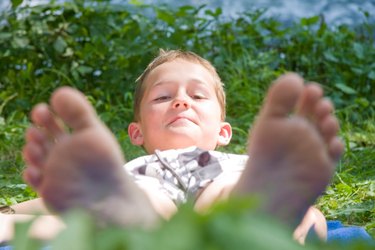
Pronation is a condition that occurs when your child's feet tilt inward. In addition to differences in walking, pronation can cause your child to develop foot abnormalities. Because pronation is best treated when your child is under the age of 5, knowing how to recognize these symptoms can ensure your child gets the treatment he needs as quickly as possible, according to Our Health Network.
Identification
Video of the Day
Children typically experience signs of pronation after age 4, according to Andorra Pediatrics, a Philadelphia, Pennsylvania-based medical practice. Have your child stand in front of you and observe her heels. If your child's feet lean inward or appear flat, these can be signs your child is experiencing pronation. Your child also might complain of knee pain, particularly after activity. Her kneecap or kneecaps might turn inward, and you might observe that the soles of her shoes wear out quickly.
Video of the Day
Causes
Pronation usually is hereditary, according to Our Health Network. The way the feet are positioned in the uterus also can determine how the feet are formed. This is called a congenital defect and causes the muscles and ligaments in the foot to become more loosely held in place, resulting in a slightly inward positioning of the foot.
Misconceptions
Because children's feet are naturally flat and the arches develop with time, pronation can be confused with flat feet, according to Sports Tek, an Australian physical therapy company. However, if your child's arch begins to develop yet flattens when he stands, this is a sign that your child may be experiencing pronation rather than flat feet.
Complications
If pronation is not treated, the bones and muscles surrounding the feet can grow abnormally, according to Our Health Network. Untreated pronation can result in problems such as shin splints, ankle sprains, knee and hip pain, lower back pain, tendinitis, muscle aches, bunions, hammer toes and calluses.
Treatments
Treatment for pronation in children depends on the child's age and level of pronation, according to Our Health Network. Examples of treatments include braces to wear at night, custom-made orthotic inserts and exercises to reduce pronation. In many cases, orthotic inserts are the chief method used to train the foot to keep it from pronating.